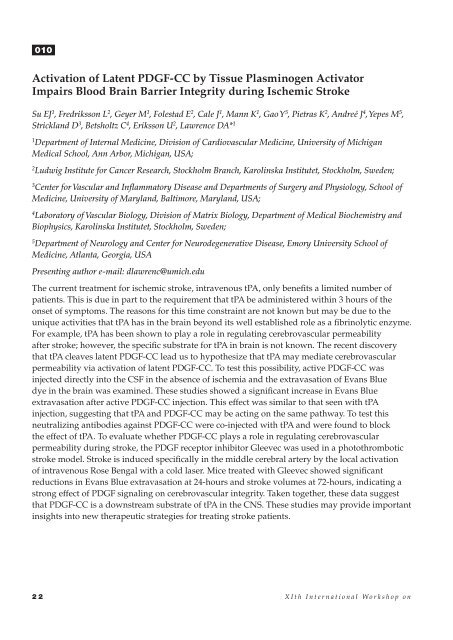Molecular and Cellular Biology of Plasminogen Activation
Molecular and Cellular Biology of Plasminogen Activation
Molecular and Cellular Biology of Plasminogen Activation
Create successful ePaper yourself
Turn your PDF publications into a flip-book with our unique Google optimized e-Paper software.
i010i<br />
<strong>Activation</strong> <strong>of</strong> Latent PDGF-CC by Tissue <strong>Plasminogen</strong> Activator<br />
Impairs Blood Brain Barrier Integrity during Ischemic Stroke<br />
Su EJ 1 , Fredriksson L 2 , Geyer M 1 , Folestad E 2 , Cale J 1 , Mann K 1 , Gao Y 3 , Pietras K 2 , Andreé J 4 , Yepes M 5 ,<br />
Strickl<strong>and</strong> D 3 , Betsholtz C 4 , Eriksson U 2 , Lawrence DA* 1<br />
1Department <strong>of</strong> Internal Medicine, Division <strong>of</strong> Cardiovascular Medicine, University <strong>of</strong> Michigan<br />
Medical School, Ann Arbor, Michigan, USA;<br />
2 Ludwig Institute for Cancer Research, Stockholm Branch, Karolinska Institutet, Stockholm, Sweden;<br />
3Center for Vascular <strong>and</strong> Inflammatory Disease <strong>and</strong> Departments <strong>of</strong> Surgery <strong>and</strong> Physiology, School <strong>of</strong><br />
Medicine, University <strong>of</strong> Maryl<strong>and</strong>, Baltimore, Maryl<strong>and</strong>, USA;<br />
4Laboratory <strong>of</strong> Vascular <strong>Biology</strong>, Division <strong>of</strong> Matrix <strong>Biology</strong>, Department <strong>of</strong> Medical Biochemistry <strong>and</strong><br />
Biophysics, Karolinska Institutet, Stockholm, Sweden;<br />
5Department <strong>of</strong> Neurology <strong>and</strong> Center for Neurodegenerative Disease, Emory University School <strong>of</strong><br />
Medicine, Atlanta, Georgia, USA<br />
Presenting author e-mail: dlawrenc@umich.edu<br />
The current treatment for ischemic stroke, intravenous tPA, only benefits a limited number <strong>of</strong><br />
patients. This is due in part to the requirement that tPA be administered within 3 hours <strong>of</strong> the<br />
onset <strong>of</strong> symptoms. The reasons for this time constraint are not known but may be due to the<br />
unique activities that tPA has in the brain beyond its well established role as a fibrinolytic enzyme.<br />
For example, tPA has been shown to play a role in regulating cerebrovascular permeability<br />
after stroke; however, the specific substrate for tPA in brain is not known. The recent discovery<br />
that tPA cleaves latent PDGF-CC lead us to hypothesize that tPA may mediate cerebrovascular<br />
permeability via activation <strong>of</strong> latent PDGF-CC. To test this possibility, active PDGF-CC was<br />
injected directly into the CSF in the absence <strong>of</strong> ischemia <strong>and</strong> the extravasation <strong>of</strong> Evans Blue<br />
dye in the brain was examined. These studies showed a significant increase in Evans Blue<br />
extravasation after active PDGF-CC injection. This effect was similar to that seen with tPA<br />
injection, suggesting that tPA <strong>and</strong> PDGF-CC may be acting on the same pathway. To test this<br />
neutralizing antibodies against PDGF-CC were co-injected with tPA <strong>and</strong> were found to block<br />
the effect <strong>of</strong> tPA. To evaluate whether PDGF-CC plays a role in regulating cerebrovascular<br />
permeability during stroke, the PDGF receptor inhibitor Gleevec was used in a photothrombotic<br />
stroke model. Stroke is induced specifically in the middle cerebral artery by the local activation<br />
<strong>of</strong> intravenous Rose Bengal with a cold laser. Mice treated with Gleevec showed significant<br />
reductions in Evans Blue extravasation at 24-hours <strong>and</strong> stroke volumes at 72-hours, indicating a<br />
strong effect <strong>of</strong> PDGF signaling on cerebrovascular integrity. Taken together, these data suggest<br />
that PDGF-CC is a downstream substrate <strong>of</strong> tPA in the CNS. These studies may provide important<br />
insights into new therapeutic strategies for treating stroke patients.<br />
22 X I t h I n t e r n a t i o n a l W o r k s h o p o n


